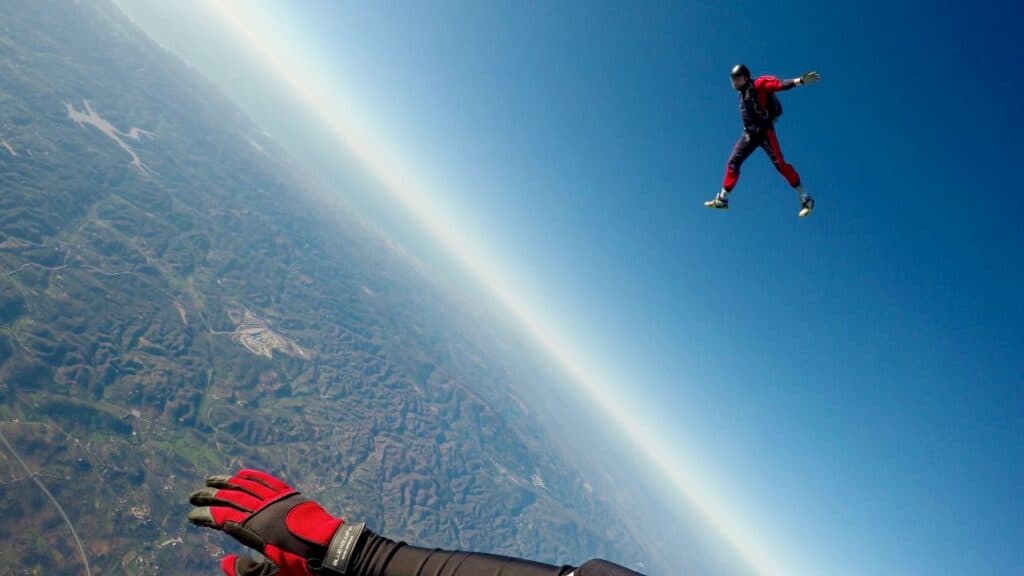
After experiencing the thrill of tandem skydiving, many people consider pursuing skydiving more seriously and obtaining a skydiving license. The certification process can seem daunting, so here is an explanation of how you become a certified skydiver.
There are different skydiving certifications, that the skydiving governing body USPA issues. The beginner skydiving license is called ‘A’ license and allows one to skydive alone. To receive the A license, students need to fulfill the following criteria:
- Perform at least 25 jumps (including five skydives with others)
- Meet the requirements on the USPA A License Proficiency Card
- Pass both the written and oral exams of the USPA
- Complete a practical skydive with a USPA instructor
- Have the license stamped by the USPA
You might be surprised to learn that there are several different types of courses available to help you obtain a skydiving license. In this blog post, I will explain the different courses, their durations, and what each one covers. I will also provide an overview of the costs involved, so you can choose the best path for you!
The Process of Obtaining a Skydiving A License
The process of earning a skydiving license can be broken down into choosing the right skydiving course for you, mastering the course and learning the required skydiving skills, and passing the examination.
Enroll in a Skydiving Course to Learn to Skydive
There are different types of skydiving courses that are designed to teach you the right skills and knowledge to master the license. Each course type is designed a little bit differently and has its pros and cons.
Accelerated Free Fall (AFF) Course – The AFF is the more modern way of teaching skydiving. You’ll receive private training from two instructors, who jump out of the plane with you. The instructors fly down next to you to help you find your balance and give you tips afterward.
AFF is often a fun way to learn skydiving because you will start with high jumps of around 10,000 ft. You also can directly experience longer free fall. However, the instructors drive up the cost of AFF, which is typically around ~2,800$.
The AFF has 7 levels that you need to complete before jumping alone solo. The total time is around 7 hours.
Static Line Course – If you’re looking for a low-cost way (~1,500$) to earn your A License, static line skydiving may be a good option. This is the original method of learning skydiving. The difference to the AFF is that you do not jump with instructors for your first jumps. Instead, a rope is used to deploy your parachute automatically.
The jump altitude is around 3,500 ft which is much lower than in an AFF course. You will also have to go through 17 levels to complete the course. That being said, the course takes around 6 hours and is therefore 1 hour shorter than the AFF.
The static line course is said to produce better canopy riders because students spend more time flying with the canopy.
Dropzone-Specific Courses – Some dropzones have created their own learning courses to differentiate themselves from other skydiving centers. There is a range of good courses out there such as the “Paraclete Student Program”, combining different training philosophies and techniques.
When choosing one of these courses, ensure that they are certified by the USPA. You should also check their training program in detail to understand if the course is enough to obtain the license or if there are extra costs involved (e.g., for performing certain jumps, required for the A license).
Fulfill the USPA A-License Requirements in the Course
Each of the courses will cover the following steps in order to help you master the license requirements.
Ground Training
Ground training is an essential aspect of any skydiving training program. During this stage, you will learn about how to properly use and maintain your skydiving equipment and adhere to important safety protocols and emergency procedures in case of equipment malfunctions or other issues.
You will also receive instruction on techniques for exiting the aircraft safely and efficiently, along with ground practice for mastering essential freefall skills such as body position, stability, and altitude awareness. You will also learn about canopy control and landing techniques, as well as how weather and environmental factors can impact your skydive.
Additionally, your ground training will cover how to communicate with your instructors and other skydivers, as well as the basic rules and regulations that are part of the sport.
Tandem Jumps
As a next step, you will practice tandem jumps and underpin the newly acquired knowledge with practice. The practice tandem jumps not only allow you to experience another rushing skydive but will also provide you with the opportunity to observe the different steps, techniques of the instructor, and safety procedures. Static line courses often skip the tandem jumps and directly let you proceed to the next step.
My first tandem jump was so much different from my first general tandem jump, after having received the ground training. Due to the training, you will notice so many different aspects of the jump that previously were left unnoticed. Without ground training, you are just a passenger but with ground training, you are a co-pilot.
Technical Jumps
In all courses, you will have to perform technical jumps, that meet the requirements of the USPA A License Proficiency Card. I provided a list of some of the most known jumps below:
- Accelerated Freefall (AFF) or Static Line Jumps: In these jumps, you wear your own parachute. You are either accompanied by an instructor who ensures your safety or are connected to a rope that is used to deploy your parachute automatically.
- Coach Jumps: After completing AFF or Static Line jumps, you move on to coach jumps where your coach teaches you more advanced maneuvers while giving you more independence in the air. You can expect to complete six of these jumps.
- Hop N Pop Jumps: These jumps simulate an aircraft emergency and teach you how to exit the plane and deploy a parachute with minimal freefall. You’ll need to complete two of these jumps to obtain your A License.
- Checkdive: In the checkdive a USPA instructor will jump with you to observe if you have the required skills to jump alone. If you fulfill the requirements, you can move on to solo jumps.
- Student Solo Jumps: After completing over a dozen jumps, you’ll begin jumping on your own while the instructor prepares and runs the jumps. These jumps are designed to build your independence in the air and you will receive less feedback from the instructor. You’ll perform them until you have completed a total of 25 jumps – required for the A license.
Following the above jumps usually gives you all the requirements specified by the USPA A License Proficiency Card.
Have you ever wondered how skydivers maneuver their bodies during freefall and safely navigate back to the ground? While it may look effortless, skydiving requires precise control and technique to achieve the desired outcomes. In this blog post, I delve into the different maneuvers skydivers use to control their movements and speed during freefall.
Pass the Oral and Written Exam to Gain the License
The USPA Instructor administers a written A-license exam, followed by an oral quiz, emphasizing topics such as equipment, safety protocols, landing procedures, and emergency scenarios. The exam covers FAR compliance, wing loading, cloud clearance, and other essential factors that affect skydiving safety.
To pass the test, you need to answer all questions correctly on the oral exam and pass the written exam with a score of at least 75%.
Complete a Practical Skydive With a USPA Instructor
As part of the USPA A-license verification process, an instructor conducts a skydive with the applicant to assess their practical knowledge, including their ability to execute maneuvers, recognize breakoff altitude, and deploy their parachute correctly. The skydiver should demonstrate proficiency in pre-jump equipment checks, traffic avoidance, and logical landing patterns that ensure a smooth flow of traffic.
The instructor afterward signs the proficiency card, which you then need to send to the USPA headquarters. You will receive an interim proficiency card from the instructor which has a 60 days validity.
How Long Does It Take to Obtain the Skydiving A License?
On average, skydiving certification courses take between 6-8 hours. To obtain the A-license, students need to complete a minimum of 25 jumps. This can take between 2-12 weeks depending on the jump frequency. Some skydiving centers offer “summer camps” in which you can gain your license in 10 days.
Can You Go Skydiving Without A Guide?
As a general rule, first-time skydivers are not allowed to jump alone without an instructor in the US, Australia, and Europe. To jump alone, skydivers must first obtain a skydiving A-license or enroll in a certified skydiving training course.
If you are upset about not being able to skydive alone without enrolling in a course or obtaining a license, remember that skydiving involves significant risk. While the idea of jumping solo may be enticing, it is crucial to prioritize safety and follow established guidelines to ensure a positive and enjoyable experience. Therefore, proper training and safety protocols are essential to minimize that risk.
Did you know that skydiving can help you overcome fears and boost your confidence in everyday life? Or that it can enhance your resilience and creativity? If you want to know more about these and other unexpected benefits of skydiving as a hobby check out this post.
That being said, enjoy your freefall!

